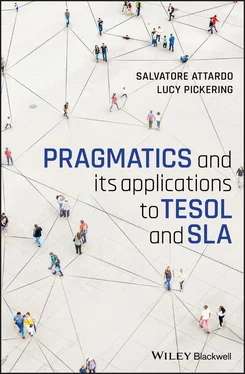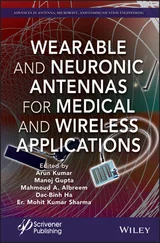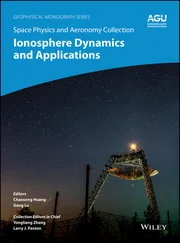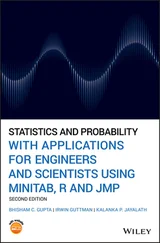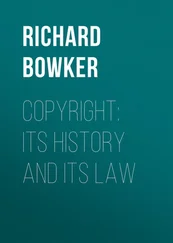Pragmatics and its applications to TESOL and SLA
Salvatore Attardo and Lucy Pickering

This edition first published 2021
© 2021 John Wiley & Sons Ltd.
All rights reserved. No part of this publication may be reproduced, stored in a retrieval system, or transmitted, in any form or by any means, electronic, mechanical, photocopying, recording or otherwise, except as permitted by law. Advice on how to obtain permission to reuse material from this title is available at
http://www.wiley.com/go/permissions.
The right of Salvatore Attardo and Lucy Pickering to be identified as the authors of this work has been asserted in accordance with law.
Registered Office(s)
John Wiley & Sons, Inc., 111 River Street, Hoboken, NJ 07030, USA
John Wiley & Sons Ltd, The Atrium, Southern Gate, Chichester, West Sussex, PO19 8SQ, UK
Editorial Office
9600 Garsington Road, Oxford, OX4 2DQ, UK
For details of our global editorial offices, customer services, and more information about Wiley products visit us at www.wiley.com.
Wiley also publishes its books in a variety of electronic formats and by print-on-demand. Some content that appears in standard print versions of this book may not be available in other formats.
Limit of Liability/Disclaimer of Warranty
The contents of this work are intended to further general scientific research, understanding, and discussion only and are not intended and should not be relied upon as recommending or promoting scientific method, diagnosis, or treatment by physicians for any particular patient. In view of ongoing research, equipment modifications, changes in governmental regulations, and the constant flow of information relating to the use of medicines, equipment, and devices, the reader is urged to review and evaluate the information provided in the package insert or instructions for each medicine, equipment, or device for, among other things, any changes in the instructions or indication of usage and for added warnings and precautions. While the publisher and authors have used their best efforts in preparing this work, they make no representations or warranties with respect to the accuracy or completeness of the contents of this work and specifically disclaim all warranties, including without limitation any implied warranties of merchantability or fitness for a particular purpose. No warranty may be created or extended by sales representatives, written sales materials or promotional statements for this work. The fact that an organization, website, or product is referred to in this work as a citation and/or potential source of further information does not mean that the publisher and authors endorse the information or services the organization, website, or product may provide or recommendations it may make. This work is sold with the understanding that the publisher is not engaged in rendering professional services. The advice and strategies contained herein may not be suitable for your situation. You should consult with a specialist where appropriate. Further, readers should be aware that websites listed in this work may have changed or disappeared between when this work was written and when it is read. Neither the publisher nor authors shall be liable for any loss of profit or any other commercial damages, including but not limited to special, incidental, consequential, or other damages.
A catalogue record for this book is available from the Library of Congress
Cover image: © Orbon Alija/Getty Images
Cover design by Wiley
Set in 9.5/12.5 STIXTwoText by Integra Software Services Pvt. Ltd, Pondicherry, India
1 Cover
2 Title page Pragmatics and its applications to TESOL and SLA Salvatore Attardo and Lucy Pickering
3 Copyright
4 Table of Contents
5 List of Tables
6 List of Figures
7 Preface
8 Typographical Conventions
9 1 Meaning1.1 What Do We Mean by Meaning? 1.1.1 Semiotics1.1.2 Extensional and Intensional Semantics1.1.3 Language in Context1.1.4 The Semantics/Pragmatics Boundary1.1.5 Modularity1.2 A Real-Life Application1.3 Conclusion
10 2 The Language Teaching and Pragmatics Interface2.1 Are There Universals in Pragmatics That Students Can Bring to Their L2?2.2 What Do Learners Typically Transfer from Their L1?2.3 Can Pragmatics be Taught through Instruction?2.4 Is There a Developmental Path for Pragmatics?2.5 Is Acquisition of Pragmatics Different for L2 Child and Adult Learners?2.6 Does the Learner Have to Sound Exactly the Same as a Native Speaker?2.7 Can Pragmatics Be Assessed in the Classroom?2.8 Conclusion
11 3 Speech Acts3.1 Ordinary Language Philosophy, Oxford, and Austin3.1.1 Austin and Performativity3.1.2 Speech Acts, Searle3.1.3 Realization Patterns3.1.4 How Speech Acts Work3.1.5 Indirect Speech Acts3.1.6 Public Commitment for Speech Acts3.2 Conclusion3.3 Speech Acts in SLA and Applications to TESOL3.3.1 Speech Acts in the TESOL Classroom: Materials3.3.2 Sample Teaching Materials
12 4 Grice’s Principle of Cooperation4.1 Gricean Pragmatics as Rational Cooperation4.1.1 Conversational Cooperation Is Rational4.1.2 Implicatures4.1.3 Scalarity and Implicatures4.1.4 Flouting and Implicatures4.1.5 Difference between Inferences, Presuppositions, and Implicatures4.1.6 Developments of Grice’s Theory4.1.7 Modularity in Light of Gricean Pragmatics4.2 Conclusion4.3 Applications to SLA4.3.1 Grice in SLA4.3.2 Relevance Theory and SLA4.3.3 TESOL Classroom Materials4.3.4 Sample Teaching Materials
13 5 Politeness5.1 Theories of Politeness5.1.1 Classical Politeness Theories5.1.2 Second Wave Approaches (1990 and Forward)5.1.3 Third Wave Theories: Ritualization and Norm5.1.4 Universality of Politeness5.1.5 Sociopragmatics and Power5.2 Conclusion5.3 Politeness and SLA5.3.1 Politeness in the TESOL Materials5.3.2 Sample Teaching Materials
14 6 Functional Sentence Perspective6.1 Theoretical Background6.1.1 Functionalism6.1.2 Markedness6.1.3 Word Order6.1.4 Prominence6.2 Aspects of FSP6.2.1 Newness6.2.2 Known-ness6.2.3 Definiteness6.3 Applications of FSP6.3.1 FSP Reflects the Organization of Ideas in the Mind6.3.2 Paragraph and Textual Organization6.3.3 Marked Constructions6.4 History and Terminology6.4.1 The Prague School6.4.2 European Functionalism6.4.3 Generative Functionalism6.4.4 West Coast Functionalism6.5 Conclusion6.6 FSP in SLA and the TESOL Classroom6.6.1 FSP in SLA6.6.2 FSP in TESOL6.6.3 Sample Teaching Materials
15 7 Stance, Deixis, and Pragmatic Markers7.1 Modality7.1.1 Modal Verbs7.1.2 Epistemic and Deontic Modality7.2 Deixis7.2.1 Place and Time Deixis7.2.2 Discourse Deixis7.2.3 Social Deixis7.3 Pragmatic Markers7.3.1 Schiffrin’s Discourse Markers7.3.2 Procedural Information Markers7.3.3 Connectors7.4 Stance7.5 Corpus-Assisted Work7.5.1 Stance Markers7.6 Conclusion7.7 Pragmatic Markers in SLA and TESOL7.7.1 Contrastive and Intercultural Studies in SLA and TESOL7.7.2 Sample Teaching Materials
16 8 Interactional Sociolinguistics8.1 The California Milieu8.1.1 The Sociological/Phenomenological Approach8.1.2 Conversation Analysis8.2 Communicative Competence8.3 The Definition of Context8.3.1 Context8.3.2 Communicative Practices8.3.3 Conversational Inferences8.3.4 Contextualization8.4 Conclusion: Gumperz’s Interactionism8.5 Sociocultural Interaction and SLA8.5.1 Interactional Sociolinguistics in the TESOL Classroom8.5.2 Sample Teaching Materials
Читать дальше
